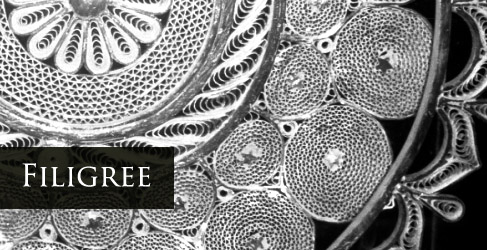Webs of Silver Strands
Lace crafted in precious metals, a mesh of shining diaphanous threads of silver and gold, an exquisite craft that is age old, yet contemporary.

Filigree, an ancient art of crafting jewellery with fine metal wires, is believed to have originated in Mesopotamia and Egypt and spread to Asia around the 2500 BC. Indian and Greek filigree still have similar patterns and processes to this day; perhaps an evidence of common influence.

Today, more than hundred families in Cuttack, Orissa, are engaged in this craft. Locally known here as “Cuttacki tarkasi”, the silver filigree of Orissa is world renowned for its delicate artistry and brilliant craftsmanship.
The process of making a silver filigree product is very peculiar in character; for it does not involve carving, engraving or moulding a block of metal into jewellery, rather, building the piece bit by bit, by joining hair thin silver wires.

Ingots of silver or gold are melted on a small stove and then poured into a mould to make rods. These rods are inserted into manual wire drawing machines with smaller and smaller apertures, resulting in fine wires – the basic ingredients of filigree. Silver is one of the most malleable and ductile metals, except gold, and one gram of pure metal can be drawn into a wire more than a kilometer long.
Designs are first drafted on a piece of paper, inspirations for which are derived from temples, the Konark wheel, gods and goddesses, flora and fauna. The wires for outlines are placed on the design sheet and shaped according to the drawing.

Hair thin wires are crimped with a machine for a zigzag effect. Using tweezers, the craftsmen carefully solder these fine wires to the outlining frame. There are about ninety types of taar (wire) designs of spirals and curls, creepers and jaals, which the craftsmen use to fill in the outlines, like delicate spider webs of silver. Taking care not to break the thin strands of silver, yet curling and twisting them with great precision, craftsmen fill in the outlines, creating delicate gauzy patterns. This process requires extreme precision. The soldered piece is then heated to fuse the joins properly. The object is then polished and sometimes lacquered, for a final finish.
Jewellery is just one of the beautiful objects of desire that the craftsmen make with filigree, along with idols of gods and goddesses, decorative animals and replicas of temples. Traditional utility items like betel nut boxes, sindoor (vermilion) containers and spoons for the first solid meal of a newborn, all are taken from mundane to extraordinary, by crafting them in silver filigree.

Filigree finds different expressions in the states of Bengal and Andhra Pradesh too. The craft that flourished under the patronage of kings and Nawabs, has seen some downfall post independence. Nevertheless, this exquisite craft still finds innumerable admirers worldwide, the dainty silver threads of filigree captivate many a fascinated soul into their gossamer web of enchanting purity.
By: Sana Karmali











Shefali
Super!
mehrzad
hi
can you make some order that i have?
i want more than 20 kg every months.
where is your factory.
i wan some filigree handicrafts.
M JAIN
Please provide your contact number, we can do it
gaatha_home
Gaatha
NDBI, NID, Paldi
Ahmedabad- 380007
Gujarat, INDIA
+ 91-79-26585002